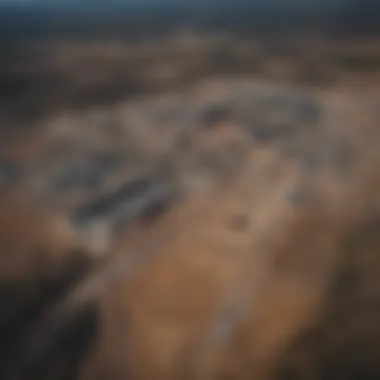Fracking Sites: Environmental, Economic, and Health Insights


Intro
Fracking, or hydraulic fracturing, has become a focal point in discussions surrounding energy production. As an influential method to extract natural gas and oil from deep underground, it invites scrutiny from various standpoints. This analysis endeavors to distill the multifaceted impacts of fracking, particularly examining environmental concerns, economic benefits, and health implications.
In recent years, advancements in technology have made fracking more prevalent. Yet, these developments also prompt important questions about sustainability and safety. Communities often engage in heated debates about the consequences of fracking operations.
The relevance of this topic cannot be overstated. As global energy demands continue to rise, the search for effective solutions remains urgent. The insights produced in this article aim to contribute to a more informed discourse regarding the implications of fracking in contemporary society.
Prelims to Fracking
Fracking, or hydraulic fracturing, occupies a central role in contemporary energy discussions. It is significant not only for its technical aspects but also for the wider implications it has on environmental health, economic growth, and public opinion. This section sets the stage for understanding fracking by clarifying its definition and exploring its historical evolution, which is essential to grasp the complexities of current debates.
Definition and Process of Hydraulic Fracturing
Hydraulic fracturing is a technique used to extract natural gas and oil from deep underground. The process involves injecting a high-pressure mixture of water, sand, and chemicals into rock formations. This action generates fractures in the rock, enabling gas or oil to flow more freely.
- Key Components: The fluid employed in fracking is mainly composed of water, but about 1% consists of various chemical additives. These chemicals aid in reducing friction and minimizing corrosion.
- Well Construction: Before the fracturing begins, a well is drilled vertically to a certain depth, followed by a horizontal drilling segment. This configuration optimizes gas recovery while minimizing surface disruption.
- Fracture Generation: During the fracturing phase, pressurized fluid is injected into the well. The fractures created can extend 1,000 feet or more from the well. As pressure is released, the fractures close partially, but the sand keeps them propped open, allowing hydrocarbons to flow.
The definition and understanding of hydraulic fracturing are crucial to appreciate the subsequent discussions on the environmental, economic, and health implications.
History of Frack Sites
The history of fracking dates back to the 1940s. Initial applications were modest, focusing primarily on enhancing oil production in specific areas. The modern era of fracking, however, began in the 1990s, when advancements in technology allowed for the development of shale deposits, which had previously been deemed uneconomical.
- Early Developments: The earliest fracking operations used only water and sand. As the industry evolved, so did the technology and chemicals employed, leading to improved extraction rates.
- Major Milestones: In 2000, the first widespread use of gas extraction from shale using fracking techniques occurred across select U.S. states. This was a turning point that heralded the shale gas boom, notably in areas like the Marcellus Shale.
- Regulatory Changes: As fracking became more prevalent, regulatory frameworks began to emerge, aiming to address safety and environmental concerns. These regulations continue to evolve as new information and technologies develop.
Understanding the history of frack sites provides valuable context for evaluating present-day practices and policies surrounding hydraulic fracturing. This historical perspective is necessary for anyone looking to grasp the ongoing debates surrounding fracking's implications for society.
Environmental Impacts of Fracking
The discussion of the environmental impacts of fracking is significant in this article because it encompasses critical aspects of ecosystem integrity, water safety, and air quality. The hydraulic fracturing process involves injecting a mixture of water, sand, and chemicals into underground rock formations to extract gas or oil. This operation can lead to various unintended environmental consequences. Understanding these implications is essential for informed decision-making regarding resource extraction, regulatory frameworks, and community health.
Water Usage and Contamination
Source Water Concerns
Source water refers to the groundwater or surface water that is utilized in the fracking process. One of the primary concerns with this is the possible contamination of these water sources during the extraction. The sourcing of large volumes of water can strain local water supplies, especially in regions suffering from drought.
Notably, the chemical composition of the fracking fluid poses risks. Heavy metals such as lead or mercury can leach into water supplies. This leads to public apprehension about water safety. Thus, the concern for source water informs policies regulating fracking sites and elevates community discussions over environmental protections.
Key characteristics of source water concerns include:
- Risk of contaminating drinking water supplies.
- Potential depletion of local water resources.
The unique feature of recognizing source water issues presents both advantages and disadvantages. While it raises awareness about potential risks, it can also result in conflicting land-use priorities, necessitating careful management.
Post-Fracking Water Management
Post-fracking water management focuses on how wastewater is handled after the fracking process is complete. This wastewater often contains high levels of contaminants, necessitating adequate treatment or disposal methods.
Effective management practices can mitigate harmful effects, such as reducing surface water pollution or protecting groundwater reserves. However, improper disposal can lead to serious ecological harm, including soil contamination and risks to aquatic life.
Key characteristics of post-fracking water management include:
- The need for proper treatment and recycling of wastewater.
- The importance of regulations governing disposal methods.
The unique aspect of this water management can provide long-term advantages, including resource recovery and sustainable practices. Yet, the challenge remains to ensure adequate infrastructure is in place, as inadequacies can lead to environmental degradation.
Air Quality and Emissions
Volatile Organic Compounds (VOCs)
VOCs are organic chemicals that can easily vaporize into the atmosphere. Their release during fracking operations raises concerning questions about air quality. These compounds can result in various health effects and contribute to smog formation.
Public health reports often indicate a correlation between VOC emissions and respiratory illnesses in nearby communities. Therefore, addressing VOCs is crucial for evaluating the overall safety of fracking activities.


Key characteristics of VOCs include:
- Impact on local air quality and human health.
- Connection to broader atmospheric pollution issues.
The recognition of VOC issues is beneficial for public awareness. While this focus can enhance health monitoring efforts, it may also provoke resistance and activism in communities affected by fracking.
Greenhouse Gas Emissions
Greenhouse gas emissions are another critical element of fracking's environmental impact. Methane, often released during the extraction and transport of natural gas, is a potent greenhouse gas. It is significantly more effective than carbon dioxide at trapping heat in the atmosphere, contributing to climate change.
The implications of these emissions are twofold. First, they raise environmental concerns regarding climate impacts. Second, they may complicate the perception of natural gas as a cleaner alternative to coal.
Key characteristics of greenhouse gas emissions from fracking include:
- Contribution to global warming.
- Critique of the sustainability of gas as an energy source.
Recognizing the greenhouse gas issue is beneficial for fostering discussions around climate policy. The challenge lies in framing energy extraction efforts within the larger context of environmental sustainability.
Impact on Wildlife and Ecosystems
Fracking disrupts local ecosystems through land use changes and habitat fragmentation. Animals may be displaced due to drilling operations or logistical activities associated with fracking sites. Additionally, chemical leaks can introduce toxins into the environment, affecting not just the immediate area but potentially neighboring ecosystems as well.
Such impacts can lead to population declines in certain species and biodiversity loss. It raises essential questions regarding conservation efforts and the trade-offs involved in resource extraction. Regulatory considerations may need to adapt to these complexities, ensuring wildlife protection is prioritized alongside economic interests in oil and gas production.
In summary, understanding the environmental impacts of fracking is crucial. It informs both public policy and community health initiatives while navigating the intricate balance between energy needs and ecological stewardship.
Economic Considerations of Frack Sites
Fracking, or hydraulic fracturing, is a method to extract oil and natural gas from underground reserves. While the environmental and health impacts are widely discussed, the economic aspects are equally significant. The fracking industry is credited with creating jobs, boosting local economies, and contributing to national energy independence. However, it also brings challenges, such as infrastructure costs and long-term economic implications that merit close scrutiny.
Job Creation and Economic Growth
Employment Opportunities
Employment opportunities generated by fracking are substantial. The fracking industry requires a diverse workforce, ranging from engineers and geologists to laborers and truck drivers. According to estimates, this sector has created thousands of jobs across various skill levels. This diversification in job opportunities makes fracking a beneficial topic for economic discussion. The key characteristic of these jobs is their contribution to workers' livelihoods in both urban and rural areas where drilling sites are located.
However, it is important to consider the nature of these jobs. Many are temporary and tied to specific projects. Workers might face job insecurity once the project ends. This situation may create a boom-and-bust cycle in local job markets, which can be a disadvantage for communities relying heavily on these jobs for economic stability.
Impact on Local Economies
The impact of fracking on local economies is profound. Fracking can drive significant economic growth in regions where hydraulic fracturing is prevalent. Local businesses, from restaurants to service stations, commonly benefit from the influx of workers and increased spending. There is a boost in demand for goods and services, which stimulates job creation and investment in the area. This property of local economies makes fracking a popular choice in energy discussions today.
Nevertheless, the economic benefits do come with caveats. While some communities thrive, others may face increased costs of living and inflation. The sudden economic growth can strain local resources, such as education, healthcare, and infrastructure. This tension between growth and sustainability is a unique feature of fracking's impact on local economies that must be examined thoroughly.
Costs Associated with Fracking
Investment in Infrastructure
Investment in infrastructure is a crucial component of fracking operations. The drilling process requires substantial infrastructure for production, transportation, and storage of oil and gas. Such investments can have a long-lasting positive impact on communities when done correctly. New roads and facilities often enhance local transportation networks, benefiting both industry and community alike.
Despite these advantages, infrastructure investment can be complicated. The costs associated with building and maintaining this infrastructure can be high, and not all regions see equal benefits. Some areas may struggle with the financial burden of infrastructure expansion, especially if the fracking activities are temporary.
Long-Term Economic Implications
Long-term economic implications can dictate the overall success of fracking in a region. While short-term gains can be appealing, they can mask the potential long-term costs and consequences. Economically, regions dependent on fracking face challenges when oil and gas prices fluctuate. A drop in market prices can lead to job losses and reduced investment.
Moreover, the environmental costs of fracking, such as water contamination and air pollution, can lead to health-related economic burdens down the line. These long-term implications highlight a need for careful planning and sustainable practices within the fracking industry. Balancing immediate economic growth with long-term sustainability remains a complex challenge for stakeholders involved in hydraulic fracturing.
“Understanding the economic considerations of frack sites involves looking beyond immediate job creation to the broader implications for communities and economies at large.”
Health Concerns Related to Frack Sites
Health concerns linked to fracking are deeply significant within the broader discourse of hydraulic fracturing. The process itself presents risks, primarily to workers at the frack sites and to the local communities that may be affected by operations. Understanding these health concerns helps clarify the potential consequences of fracking beyond its economic benefits and environmental impacts. Addressing health issues is crucial because it involves human life and wellbeing, focusing on both immediate and long-term effects.
Potential Health Risks for Workers
Exposure to Hazardous Chemicals


Exposure to hazardous chemicals is a primary concern for workers involved in fracking. During the fracturing process, various chemicals are utilized, which can pose a danger. Workers may be exposed to toxic substances such as benzene and formaldehyde. These have significant health implications, including respiratory issues and potential carcinogenic effects. Addressing this risk is essential because worker safety should be a paramount concern for any operation.
The key characteristic of this exposure is the unpredictable nature of chemical reactions that can occur at frack sites. Workers often have to handle these substances without adequate protection, creating situations where health risks increase. In this article, it is crucial to examine these risks thoroughly. Unique features include potential long-term illnesses developing as a result of prolonged exposure. Understanding these health risks contributes to a more comprehensive analysis of fracking's implications, emphasizing the necessity for stringent safety measures and protective regulations.
Health Monitoring and Mitigation
Health monitoring and mitigation play a vital role in reducing risks associated with fracking. Continuous health assessments can help identify early symptoms of health issues among workers. Regular testing can provide insights into the efficacy of safety measures implemented at the sites. This monitoring is a beneficial aspect of fracking operations, serving as a proactive approach to address potential health hazards before they escalate.
A crucial characteristic here is the need for comprehensive health plans that include education about hazardous exposure. This is essential to empower workers and ensure they understand the risks associated with their jobs. The unique feature of health monitoring is its ability to catch issues early, but it also has its downsides. Comprehensive health monitoring can be resource-intensive. Balancing resources while maintaining a focus on worker health is an ongoing challenge within the fracking industry.
Impact on Local Communities
Community Health Outcomes
Community health outcomes are significantly affected by the presence of fracking operations nearby. There are numerous studies suggesting a correlation between fracking and increased incidents of respiratory diseases among residents. Air pollutants released during the fracking process can contribute to adverse health effects, impacting vulnerable populations such as children and the elderly. Investigating community health outcomes is essential in measuring the overall impact of fracking on nearby locals.
A key characteristic of these outcomes is their long-term nature. Health effects may not be immediately observable, but they can emerge over time, creating a more complex picture of community health. Unique features of this issue include the challenge of establishing direct causation between fracking and health impacts. Understanding these community concerns is a vital aspect of the conversation surrounding hydraulic fracturing. It informs policy decisions and encourages accountability for health outcomes.
Access to Healthcare Resources
Access to healthcare resources is often a critical concern for communities affected by fracking. Increased economic activity and associated population growth can strain local healthcare systems. Communities near frack sites may experience difficulties accessing care due to a sharp rise in demand. Analyzing access to healthcare resources helps illustrate how fracking might indirectly affect community health.
A central characteristic of this issue is the potential disparity created by fracking operations. Wealthier areas may experience better healthcare access, while poorer communities are left with limited resources. The unique nature of this situation creates a need for equitable healthcare solutions, ensuring everyone can receive necessary medical care. Understanding how these dynamics function is important for evaluating the comprehensive impact of fracking on public health.
"Health outcomes related to fracking operations extend beyond the immediate risks faced by workers and infiltrate the health of entire communities. It underscores the importance of public health in the conversation on energy production."
In summary, health concerns related to frack sites encompass a range of issues, focusing on worker safety and community health. Each aspect carries its implications and challenges. By examining these elements, the article aims to provide a detailed analysis of how fracking affects human health, emphasizing the need for rigorous safety standards and community health initiatives.
Regulatory Framework Governing Frack Sites
The regulatory framework for fracking is vital for understanding how hydraulic fracturing operations are managed and overseen. This section examines the components of these regulations, highlighting their significance for environmental protection, public health, and the economic stability of local communities. Additionally, the interaction between federal and state regulation play a crucial role in shaping the operational landscape of frack sites.
Federal Regulations
Federal regulations serve as the cornerstone for overseeing fracking practices across the United States. The Environmental Protection Agency (EPA) is the main federal body tasked with regulating many aspects of hydraulic fracturing. Key components of federal regulations include:
- Safe Drinking Water Act (SDWA): This act defines the framework for protecting the quality of drinking water. It mandates that fracking companies must disclose the chemicals used in their operations to prevent contamination of underground sources of drinking water.
- Clean Air Act (CAA): Under this act, emissions from fracking sites fall under specific air quality standards. Companies must manage and report their air emissions, focusing on preventing pollutants from affecting the surrounding environment and local communities.
- National Environmental Policy Act (NEPA): This requires comprehensive assessments for any federal action that significantly affects the environment. Fracking companies must undergo rigorous environmental impact assessments before operations can commence.
"The regulatory landscape ensures that fracking operations minimize their impact on public health and the environment."
Although there are federal standards in place, compliance and enforcement can vary significantly. The effectiveness of these regulations relies heavily on the capacity and commitment of regulatory agencies.
State-Level Regulatory Differences
State regulations add another layer of complexity to the governance of fracking. Each state has its own set of rules and requirements, which leads to significant variations. Notable differences may include:
- Permitting Processes: States have distinct permitting procedures before fracking can begin. Some states mandate extensive public consultation, while others may have streamlined processes with limited community input.
- Chemical Disclosure Laws: States differ in how they handle the disclosure of chemicals used in fracking fluid. Some states require full disclosure, while others allow for proprietary chemicals to remain confidential.
- Wastewater Management: The regulations surrounding the disposal and recycling of wastewater are also subject to state laws, which can influence the health and safety outcomes for local communities.
Understanding these regulatory differences is essential for stakeholders. It highlights the importance of localized approaches to fracking that can address specific environmental and health concerns relevant to each region.
Community Responses to Fracking
Addressing community responses to fracking is essential in understanding its broader implications. Communities near frack sites often experience a range of reactions from acceptance to strong opposition. Awareness and activism can significantly shape the dialogue surrounding hydraulic fracturing. As local populations grapple with its consequences, their voices play a critical role in shaping policies and practices. Recognizing community responses allows for a more comprehensive analysis of fracking's many facets. It also sheds light on the dynamics between corporations and citizens.
Public Awareness and Activism
Grassroots Movements
Grassroots movements focus on mobilizing local communities to advocate for or against fracking. These organizations often emphasize the importance of local knowledge and experiences. They typically thrive on community involvement and empowerment, which are vital to their effectiveness. A key characteristic is their ability to unite diverse groups around common goals, such as protecting natural resources.
Grassroots movements provide a unique advantage in that they can address specific local issues that larger organizations might overlook. They often work directly with affected communities to raise awareness and educate locals about the potential risks of fracking. However, they can face challenges related to funding and resources, which may limit their reach. Still, their organic connection to the community can foster genuine support and sustained advocacy.
Role of Social Media
The role of social media in fracking discussions cannot be overstated. It serves as a platform for activists to disseminate information rapidly. Social media allows for widespread communication and enables communities to share their concerns and success stories. A significant characteristic of social media is its ability to engage younger audiences, who may otherwise be uninterested in traditional activism.


This unique feature offers an advantage in reaching a broader demographic. However, social media can also lead to misinformation. Misinformation can spread quickly alongside accurate data, complicating the conversation around fracking. It is imperative for users to critically evaluate the information they encounter while participating in these online forums. Still, when used correctly, social media can enhance public engagement and drive local activism.
Legal Challenges and Community Actions
Legal challenges are a critical aspect of community responses to fracking. Residents may pursue litigation to protect their land and health. Lawsuits often focus on issues such as water contamination, air quality violations, or safety concerns. Successful legal actions can lead to stricter regulations or even halt fracking activities. These legal avenues empower communities and emphasize the importance of safeguarding their rights.
Community actions can take various forms. Some communities participate in public hearings, while others may organize protests or awareness campaigns. Such actions not only highlight local concerns but also draw national attention to the issues at hand. When citizens are actively engaged in these legal and community efforts, they can make significant strides toward influencing policymakers and corporate practices regarding fracking.
Technological Innovations in Fracking
Technological advancements play a crucial role in modern fracking operations. These innovations aim to enhance efficiency, reduce environmental impact, and ensure the safety and health of those involved in the process. Understanding these technologies is vital, as they can redefine the future of energy extraction and its associated challenges.
Advancements in Fracking Technology
One significant area of innovation is the improvement of drilling techniques. New methods, like horizontal drilling, allow for extracting oil and gas from areas that were previously inaccessible. This technique not only maximizes the yield from a single well but also diminishes the number of wells required, thus minimizing surface disturbance and landscape alteration.
Another advancement is the use of advanced hydraulic fracturing fluids. These are specially formulated to reduce the amount of water used and minimize chemical impact on the surrounding environment. Companies are now utilizing more biodegradable and non-toxic components, addressing environmental concerns linked to traditional fracking fluids. This shift enhances public confidence in the safety of fracking operations.
Moreover, the integration of data analytics and Artificial Intelligence (AI) in fracking operations has transformed the way companies operate. Real-time monitoring of drilling parameters helps in optimizing performance, reducing downtime, and predicting potential failures before they occur. This proactive approach not only saves costs but also contributes to the overall safety of the operations.
Environmental Monitoring Technologies
Environmental monitoring is a crucial facet of modern fracking practices. Sophisticated technologies enhance the ability to track potential impacts on water quality and air emissions. One such technology is the use of satellite imagery and remote sensing. These tools help in detecting changes in land use and vegetation, providing early warnings of any disturbances in the area surrounding frack sites.
Moreover, sensor technologies are increasingly deployed to monitor air emissions. These sensors can detect volatile organic compounds (VOCs) and other pollutants around the clock. By identifying emissions more accurately and in real time, companies can swiftly address leaks and prevent harmful releases into the atmosphere.
"Technological progress is not linear; innovations can dramatically change operational landscapes, especially in industries like fracking."
Additionally, water quality testing technologies have advanced significantly. Automated systems can continuously sample water from nearby sources, checking for contaminants that may arise from fracking activities. Early detection allows for timely responses, which is critical for both public health and environmental preservation.
Future Perspectives on Fracking
The future of fracking is an essential topic within the broader analysis of environmental, economic, and health perspectives. Understanding how hydraulic fracturing will evolve is critical for stakeholders, including policymakers, industry leaders, and community members. Both potential benefits and hazards must be assessed as the energy landscape continues to shift.
Shifts in Energy Policy
Recent trends in energy policy are shaping the fracking industry. Governments around the world are increasingly focusing on reducing carbon emissions and transitioning towards renewable energy sources. In this context, fracking faces scrutiny due to its environmental footprint.
The following points highlight how energy policies are affecting fracking:
- Regulatory Changes: New environmental regulations may limit fracking operations, imposing stricter standards to protect air and water resources.
- Subsidies for Renewables: As governments allocate more financing to renewable energy projects, traditional fossil fuel extraction might see reduced investments, affecting fracking's economic viability.
- Public Sentiment: As awareness grows regarding climate change and environmental degradation, public support for fracking may wane, pressuring governments to rethink energy policies.
These shifts indicate a complex future for fracking, influenced by a mix of political, social, and environmental considerations. Those engaged in the energy sector must adapt strategically to align with these emerging policies.
The Role of Fracking in Renewable Energy Transition
Fracking's role in transitioning to renewable energy is multifaceted. While critics argue that it contradicts the goals of sustainable development, proponents underscore its potential to serve as a bridge fuel. The following considerations illustrate this perspective:
- Natural Gas as a Transition Fuel: Natural gas extracted through fracking could replace coal and oil, potentially reducing greenhouse gas emissions in the short term.
- Energy Security: Maintaining a diverse energy portfolio, which includes fracked natural gas, can help stabilize the energy grid as renewables like wind and solar grow in capacity.
- Economic Feasibility: By leveraging domestic resources through fracking, countries may enhance their energy independence, reducing reliance on imports.
Ultimately, the dialogue surrounding fracking needs to address these elements. Stakeholders must understand how fracking can fit within a broader sustainable energy framework while carefully considering its environmental impacts.
"The development of efficient regulatory frameworks is essential for balancing energy production and environmental protection."
Culmination
The conclusion of this article provides a significant opportunity to reflect on the complex dynamics surrounding fracking and its broad implications. As highlighted throughout the sections, hydraulic fracturing plays a dual role in energy production. It provides substantial economic benefits while simultaneously posing environmental and health risks that require careful management.
Summary of Key Findings
In summary, this article presented several critical findings regarding fracking:
- Environmental Impacts: Fracking has shown notable negative effects on local water resources, air quality, and ecosystems. Water usage remains a significant concern, especially considering the potential for contamination.
- Economic Factors: On the economic front, fracking contributes to job creation and local economic growth. However, there are hidden costs that arise from infrastructure needs and potential long-term economic implications.
- Health Concerns: Public health risks are prevalent both for workers directly involved in fracking and for local communities. Understanding these risks is essential for developing effective monitoring and response strategies.
- Regulatory Landscape: The regulatory environment varies widely across states, leading to inconsistencies in fracking practices and oversight. This factor complicates the establishment of uniform safety standards.
- Community Responses: Various community movements and legal actions reflect growing public awareness of the negative aspects of fracking, demonstrating the importance of public engagement in energy policies.
Recommendations for Future Research
Looking ahead, several critical areas for future research can enhance understanding and practices related to fracking:
- Longitudinal Studies: Conduct long-term studies that monitor the environmental and health impacts of fracking over time to develop clearer causal relationships.
- Technology Assessment: Research on technological advancements aimed at minimizing the environmental footprint of fracking should be prioritized. Innovations can play a pivotal role in enhancing safety and sustainability.
- Social Impact Evaluation: More comprehensive assessments of the social impacts on local communities, particularly in areas surrounding frack sites, can provide insights into the broader implications of hydraulic fracturing.
- Comparative Analysis: Cross-state comparative studies of regulatory frameworks may yield valuable lessons for effective governance and policy implementation in fracking areas.
"Understanding the multifaceted nature of fracking is crucial for informed decision-making in energy policy."
These recommendations aim to address the gaps identified in the existing literature and foster a more balanced approach to hydraulic fracturing.







